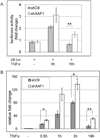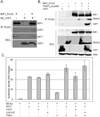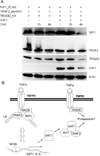X-linked inhibitor of apoptosis-associated factor 1 regulates TNF receptor 1 complex stability
- PMID: 27768232
- PMCID: PMC5154952
- DOI: 10.1002/1873-3468.12467
X-linked inhibitor of apoptosis-associated factor 1 regulates TNF receptor 1 complex stability
Abstract
X-linked inhibitor of apoptosis (XIAP)-associated factor 1 (XAF1) is a cytokine-regulated, tumor necrosis factor (TNF) receptor-associated factor (TRAF) domain-containing protein that has a poorly defined cellular function. Here, we show that ectopically expressed XAF1 inhibits TNF-ɑ-induced NF-κB activation, whereas shRNA silencing of endogenous XAF1 augments it. Our data suggest that XAF1 may inhibit TNF-ɑ-induced NF-κB activation by disrupting the assembly of the TRADD/TRAF2/RIP1 complex (complex I) downstream of TNF receptor activation. XAF1 interacts with TRAF2 and inhibits TRAF2-dependent NF-κB activation, in part, by blocking TRAF2 polyubiquitination. Our findings also indicate that although XAF1 does not directly inhibit RIP1-dependent NF-κB activation, it binds RIP1 and disrupts RIP1/TRADD association. Our data suggest that XAF1 acts as a feedback regulator of the TNF receptor signaling pathway to suppress NF-κB activation.
Keywords: Receptor interacting protein kinase 1; XIAP associated factor 1; inflammatory response; nuclear factor-kappa B; tumor necrosis factor; tumor necrosis factor receptor-associated factor 2.
© 2016 Federation of European Biochemical Societies.
Figures









Similar articles
-
Tumor necrosis factor (TNF) receptor-associated factor (TRAF)-interacting protein (TRIP) negatively regulates the TRAF2 ubiquitin-dependent pathway by suppressing the TRAF2-sphingosine 1-phosphate (S1P) interaction.J Biol Chem. 2015 Apr 10;290(15):9660-73. doi: 10.1074/jbc.M114.609685. Epub 2015 Feb 25. J Biol Chem. 2015. PMID: 25716317 Free PMC article.
-
Y14 positively regulates TNF-α-induced NF-κB transcriptional activity via interacting RIP1 and TRADD beyond an exon junction complex protein.J Immunol. 2013 Aug 1;191(3):1436-44. doi: 10.4049/jimmunol.1300501. Epub 2013 Jul 1. J Immunol. 2013. PMID: 23817415
-
AWP1 binds to tumor necrosis factor receptor-associated factor 2 (TRAF2) and is involved in TRAF2-mediated nuclear factor-kappaB signaling.Int J Biochem Cell Biol. 2011 Nov;43(11):1612-20. doi: 10.1016/j.biocel.2011.07.010. Epub 2011 Jul 26. Int J Biochem Cell Biol. 2011. PMID: 21810480
-
Verproside inhibits TNF-α-induced MUC5AC expression through suppression of the TNF-α/NF-κB pathway in human airway epithelial cells.Cytokine. 2016 Jan;77:168-75. doi: 10.1016/j.cyto.2015.08.262. Epub 2015 Aug 28. Cytokine. 2016. PMID: 26318254
-
Evidence that TNF-TNFR1-TRADD-TRAF2-RIP-TAK1-IKK pathway mediates constitutive NF-kappaB activation and proliferation in human head and neck squamous cell carcinoma.Oncogene. 2007 Mar 1;26(10):1385-97. doi: 10.1038/sj.onc.1209945. Epub 2006 Sep 4. Oncogene. 2007. PMID: 16953224
Cited by
-
Genome-wide screening of SARS-CoV-2 infection-related genes based on the blood leukocytes sequencing data set of patients with COVID-19.J Med Virol. 2021 Sep;93(9):5544-5554. doi: 10.1002/jmv.27093. Epub 2021 May 28. J Med Virol. 2021. PMID: 34009691 Free PMC article.
-
Differential transcriptional and functional properties of regulatory T cells in HIV-infected individuals on antiretroviral therapy and long-term non-progressors.Clin Transl Immunology. 2021 May 26;10(5):e1289. doi: 10.1002/cti2.1289. eCollection 2021. Clin Transl Immunology. 2021. PMID: 34094548 Free PMC article.
References
-
- Gruss HJ, Dower SK. Tumor necrosis factor ligand superfamily: involvement in the pathology of malignant lymphomas. Blood. 1995;85:3378–3404. - PubMed
-
- Tartaglia LA, Goeddel DV. Two TNF receptors. Immunol Today. 1992;13:151–153. - PubMed
-
- Tracey KJ, Cerami A. Tumor necrosis factor: a pleiotropic cytokine and therapeutic target. Annu Rev Med. 1994;45:491–503. - PubMed
-
- Chen G, Goeddel DV. TNF-R1 signaling: a beautiful pathway. Science. 2002;296:1634–1635. - PubMed
-
- Hsu H, Shu HB, Pan MG, Goeddel DV. TRADD-TRAF2 and TRADD-FADD interactions define two distinct TNF receptor 1 signal transduction pathways. Cell. 1996;84:299–308. - PubMed
Publication types
MeSH terms
Substances
Grants and funding
LinkOut - more resources
Full Text Sources
Other Literature Sources
Research Materials
Miscellaneous

